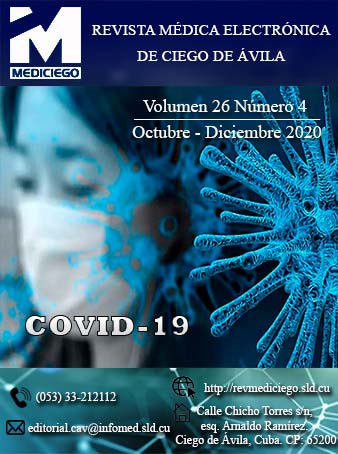Educational intervention on deforming oral habits in preschool children
Abstract
Introduction: deforming oral habits are common in children; they interfere with the normal development of the stomatognathic apparatus and cause deforming malocclusions.Its detection, prevention and control are essential for oral health.
Objective: to evaluate the effectiveness of an educational intervention on deforming oral habits in preschool children from April to June 2017.
Methods: an educational intervention with a before and after design was carried out, in three stages, in a population of 49 children from a day care centerin Mayarí, Holguín province.Theoretical and empirical methods were applied. The ethical principles of the research were complied with.
Results: finger suction predominated (32,65 %). Deforming oral habits decreased (before 57,14 %; after 18,37 %) and the level of knowledge increased (before 77,55 %; after 93,88 %.).
Conclusions: the educational intervention was effective. Risk factors were acted on early to avoid dentomaxillofacial abnormalitiesDownloads
Published
How to Cite
Issue
Section
License
Those authors who have publications with this journal accept the following terms of the License CC Attribution-NonCommercial 4.0 International (CC BY-NC 4.0):
You are free to:
- Share — copy and redistribute the material in any medium or format for any purpose, even commercially.
- Adapt — remix, transform, and build upon the material for any purpose, even commercially.
The licensor cannot revoke these freedoms as long as you follow the license terms.
Under the following terms:
- Attribution — You must give appropriate credit , provide a link to the license, and indicate if changes were made . You may do so in any reasonable manner, but not in any way that suggests the licensor endorses you or your use
- No additional restrictions — You may not apply legal terms or technological measures that legally restrict others from doing anything the license permits.
The journal is not responsible for the opinions and concepts expressed in the works, which are the exclusive responsibility of the authors. The Editor, with the assistance of the Editorial Committee, reserves the right to suggest or request advisable or necessary modifications. Original scientific works are accepted for publication, as are the results of research of interest that have not been published or sent to another journal for the same purpose.
The mention of trademarks of specific equipment, instruments or materials is for identification purposes, and there is no promotional commitment in relation to them, neither by the authors nor by the editor.






















